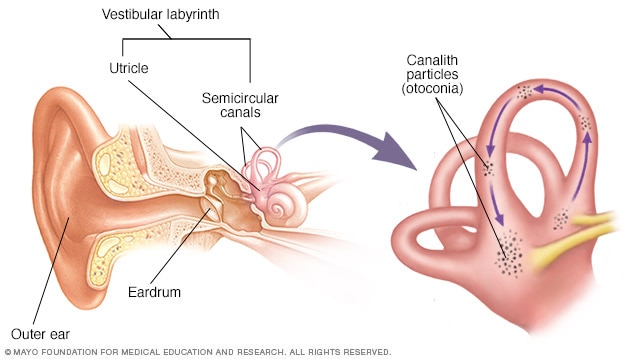Vertigo and dizziness are two words that are easily confused as they both refer to sensations of impaired balance. In this article, you will find out more about the differences between these two symptoms, the most common cause of vertigo and its treatment.
The connection between vertigo and the ears
In addition to housing our hearing system, our ears also help us to maintain spatial awareness and play a key role in our sense of balance. Therefore, the causes of vertigo and dizziness are directly related to our ears.
According to Gaceta Audio magazine, vertigo and dizziness are a very common reason for seeking medical attention and between 20-30% of the world’s population are affected by these symptoms.
What is the difference between vertigo and dizziness?
- Dizziness is an umbrella term used to describe a variety of sensations, such as unsteadiness and loss of equilibrium or lightheadedness, and can be caused by a sudden movement, a drop in blood pressure or dehydration. Episodes of dizziness are usually short-lived and resolve spontaneously.
- Vertigo is a symptom that is caused by a dysfunction in the vestibular system (inner ear), while dizziness is a balance issue. Vertigo produces a spinning sensation, making those affected feel like their surroundings are moving or that they themselves are doing so involuntarily. In 85% of cases, the root causes lies in the inner ear. It is also important to point out that women between the ages of 40 and 60 are most likely to be affected by vertigo, as at this age, the structures in the inner ear begin to deteriorate, affecting the ear’s function and leading to balance issues.
BPPV: Benign Paroxysmal Positional Vertigo
Fluid moves through the ear’s semi-circular canals to allow the brain to detect the body’s position. This fluid is displaced with every movement of the head, helping us to maintain our balance.
In cases of BPPV, or Benign Paroxysmal Positional Vertigo, small calcium crystals (canalith particles or otoconia) migrate into the fluid. When the patient moves their head, the particles interfere with the normal fluid movement and cause the ear to send false signals about the body’s position to the brain. This causes a spinning sensation as the brain interprets that either the patient or their surroundings are moving. People who suffer vertigo can also experience nausea and vomiting, and episodes of vertigo can resolve spontaneously for a period of time before returning some time later.

Benign Paroxysmal Positional Vertigo is the most frequent cause of vertigo in the world, andit is estimated that 1 in 3 people will suffer BPPV at some point in their life.
Treating vertigo
Healthcare professionals recommend treating BPPV with the canalith repositioning procedure, a series of slow, simple movements that help to reposition the head.
The idea is that these movements will shift the particles that are floating in the fluid in the semi-circular canals to a part of the ear where they will not cause any symptoms. The procedure has a high success rate, although several sessions may be required for BPPV symptoms to resolve completely. If, however, treatment fails and the professional is unable to reposition the canaliths in the patient’s ear, surgery is also a viable alternative.
It is important that you seek medical advice if you experience recurring episodes of dizziness or vertigo with no apparent cause. An ENT specialist will assess your symptoms and be able to advise which is the best treatment plan for you.
Have you ever suffered from vertigo or experienced dizzy spells? What advice did your healthcare specialist offer you? We look forward to reading your comments!
Credit photo: mayoclinic.org

Good content and all the information regarding Diziness is there in this blog very rich content you are having on this page loved to be a member of this page keep up the good work guyz, you are doing a great job for awareness.
Thanks a lot, Arif, for your nice words to our blog. Really appreciate them! 🙂
Good content you are having on this page loved to be a member of this page keep up the good work guyz, you are doing a great job for awareness.
Thank you so much for your kind words, Amit! We really appreciate them 🙂
I like the suggestion you made to try the canalith repositioning procedure with manipulations to work with the particles in the semicircular canals. I did not know that this can reduce symptoms of vertigo. I have been having problems with this for about a year now and it is starting to get in the way of safety. I have fallen downstairs a couple of times now. I will contact a physiotherapy specialist as soon as possible. When I do I will mention this technique.
Thank you so much your comment sharing your experience with us. Our recommendation is to visit an specialist and maybe try this technique, always monitored by him. We really hope this work on you! 🙂
Vertigo is a medical condition that is characterized by dizziness and spinning sensation. It is an abnormal sensation of movement experienced by the patient. Vertigo may be caused due to a number of reasons. Vertigo is considered to be one of the most common neurological disorders. Vertigo can be treated with a combination of medicines and exercises. Thank you for sharing such valuable article.
Thank you so much for your kind feedback!
Very good article about Vertigo Treatment . it’s really important information for the Audience.
Thank yoy for your feedback!